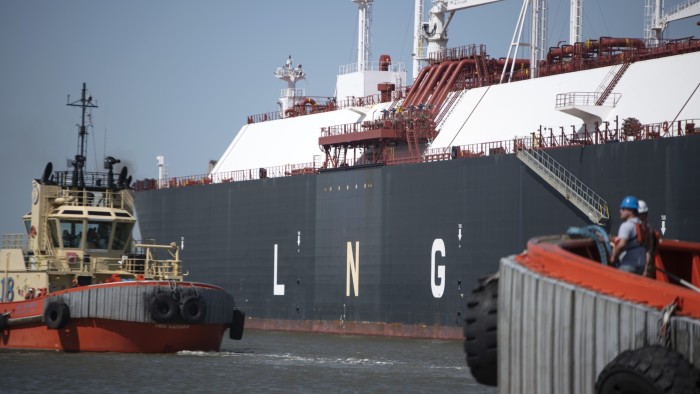Unlock the Editor’s Digest for free
Roula Khalaf, Editor of the FT, selects her favourite stories in this weekly newsletter.
Charter rates for ships carrying liquefied natural gas have hit record lows, with some owners now facing a loss if they lease their vessels out, as the sector grapples with huge overproduction in the wake of Europe’s energy crisis two years ago.
The cost of hiring a modern LNG carrier — the dominant vessel type on the market — on a short-term basis in the Atlantic basin was on average $19,700 a day in November, according to data from Spark Commodities, the lowest assessed in data going back to 2019.
Rates have fallen nearly 80 per cent since the summer, as the delivery of new ships outpaces the growth in global LNG production.
Brokers, analysts and LNG traders said that headline rates for older, less efficient vessels had plunged as well. For the LNG carriers that run on steam turbines, the most inefficient on the market, “the earnings, once elements such as operational costs are deducted, are in a lot of cases negative or near zero”, one broker said.
Such low rates mean some shipowners may not be able to cover their costs from letting their vessels out, and are likely to lead to a period of readjustment in the industry, for instance by the scrapping of older ships.
Negative charter rates for LNG carriers are rare but were recorded by Spark in February 2022, in the run-up to Russia’s invasion of Ukraine. Fuel costs, which Spark assumes the shipowners pay on the vessel’s ballast leg — when it is not carrying cargo — soared due to the imminent attack, leading to negative rates being assessed.
The fall in charter rates this year has been driven by the large number of vessels hitting the market at a time when the actual commodity they deliver has not come online as quickly as expected due to project delays.
Shipowners had placed a significant number of orders during the European energy crisis triggered by the Russian invasion. They were betting that demand for seaborne fuel would rise, driven by Europe’s need to replace lost Russian pipeline gas with LNG imports, as the Kremlin began slashing supplies even before the full-scale war began.
There were around 650 LNG carriers in operation as of last year, according to International Gas Union, an industry group. Sixty-eight vessels would have been added to that pool by the end of this year and 88 in 2025, according to Flex LNG, an LNG shipping company. More than 80 ships will be delivered each year through to 2027, according to Flex.
However, the additional volumes of LNG exports that these vessels wee ordered for have not materialised in the timeframe expected, mainly due to delays in the development of LNG export facilities in the US, now the world’s largest exporter of the superchilled fuel and the main source for Europe.
LNG export volumes typically rise around 6 to 8 per cent a year, but this year is likely to see only 1 per cent growth, said Oystein Kalleklev, CEO of Flex LNG, on an earnings call in November. “This is also one of the explanations why the [freight] spot market is trading poorly,” he said.
Additionally, Europe has not imported as much LNG as in previous years due to the high level of gas left in storage after last winter proved milder than normal, limiting the use of such vessels.
Traders also did not this year utilise floating storage — keeping laden LNG vessels on the water until prices rise in the run-up to winter — as much as previous years because of the lack of a major price difference between summer and winter prices. This has released more carriers.
Some older vessels are also being freed from long-term contracts this year, brokers say, adding to the glut of ships.
Actual charter deals at zero or negative rates have so far this time not taken place and remain theoretical for now, say brokers and analysts. However, owners of the older ships may be inclined to lease them out at such rates — which would help keep their LNG storage tanks at the necessary cool temperature — after weighing the costs of either taking them out of service or scrapping them.
“Real charter agreements could emerge where owners let out a vessel at a headline rate of or close to zero for a short time,” said Clare Pennington, LNG shipping expert at commodity consultancy ICIS. “What could happen is a situation where some owners are stuck with a steam vessel and are balancing the cost of [taking it off market] or letting it out so it doesn’t warm up.
“It will also depend on how long owners might have to wait to scrap a vessel, and making calculations on what costs them less,” she said.
While energy companies forecast that demand for LNG will surge in the coming decades, mostly from developing Asian countries switching their fuel from coal to gas, LNG freight rates in the short term are likely to be depressed, say analysts.
Martin Senior, deputy head of LNG pricing at Argus Media, a pricing agency, said that while 251 new-build carriers were due to be delivered between 2025 and 2027, the new export capacity coming online in the same period might require only 171 additional carriers.
“The market is pricing in a well-supplied LNG carrier market next year with forward [freight] rates for 2025 far below levels seen in previous years,” Senior said.
Additional reporting by Oliver Telling
Read the full article here

